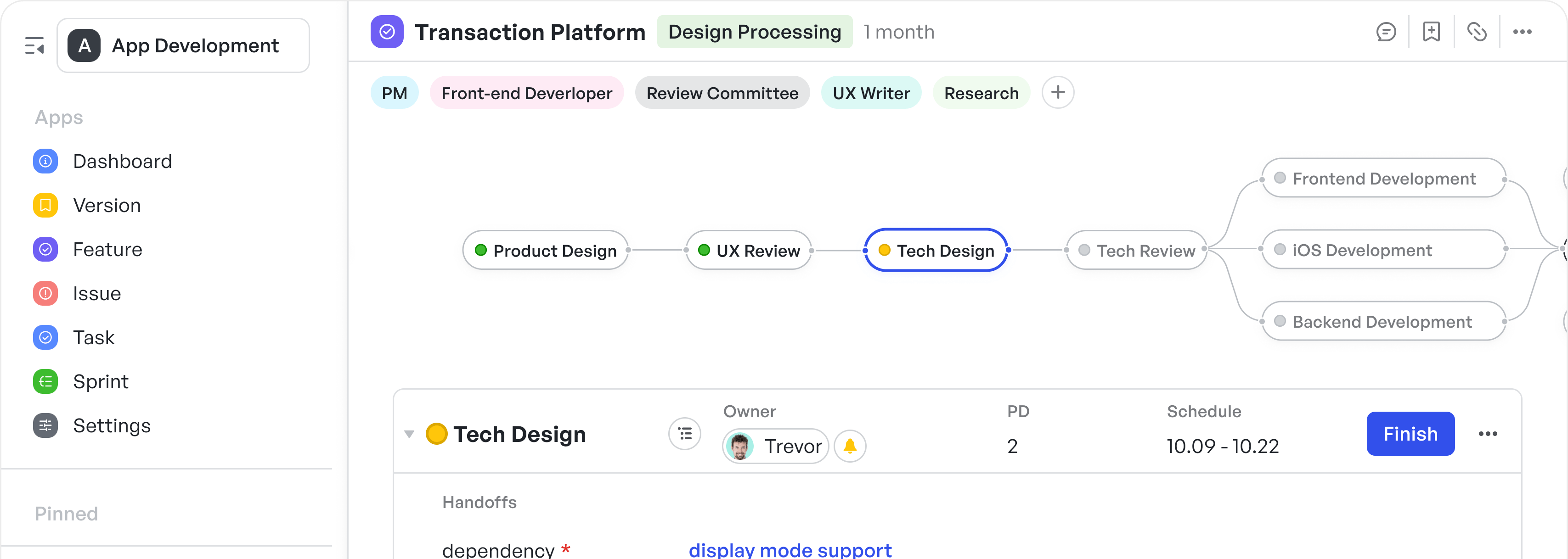Project Management Methodologies: Which One Is Best for You?

Choosing the right project management methodology is critical to your team's success. You know this, but how do you choose?
This guide breaks down 12 popular frameworks (with examples) and offers practical tips to help you choose one that fits your workflow.
You'll also see how Meegle, a flexible project management tool with built-in templates, can support each methodology, making it easier to get started and stay organized.
What is project management methodology?
A project management methodology is a structured approach to planning, executing, and completing projects. It outlines the roles, steps, tools, and techniques teams use to stay organized and deliver results.
Common examples include Agile, Scrum, and Waterfall—along with four other project management methodologies covered below.
What you'll get:
- A breakdown of the 12 proven project management techniques
- Project management templates
- A practical guide to picking the fitting project management methodology for your team
Types of project management methodologies
Check this quick tabular breakdown of the different types of project management methodologies.
| Methodology | Quick use case | Complexity level |
|---|---|---|
| Agile | Software teams needing flexibility and continuous delivery | Medium |
| Scrum | Teams working in sprints with structured roles | Medium |
| Kanban | Visual task tracking and flow optimization | Low |
| Waterfall | Projects with clear, fixed stages and requirements | Low–Medium |
| Lean | Eliminating waste and maximizing efficiency | Medium |
| PRINCE2 | Large-scale, highly structured enterprise projects | High |
| Extreme Programming (XP) | Agile teams requiring rapid feedback and technical discipline | High |
| Six Sigma | Projects requiring data-driven quality control and defect reduction | High |
| Critical Path Method | Planning projects with task dependencies and fixed timelines | Medium |
| Hybrid | Combining Agile and Waterfall for flexible yet structured delivery | Medium–High |
| Precedence Diagramming Method | Projects needing detailed task sequencing with visual relationships | Medium |
| Critical Chain Project Management | Managing projects with resource constraints and buffer-based planning | High |
Before we get into the different PM methodologies, here's a quick question:
Why so many project management methodologies?
Every project needs structure to guide decisions, track progress, and align the team. Hence, the need for a project management methodology (PMM). It provides a blueprint for how work gets done. And for years, the go-to PMM was Waterfall.
In a whitepaper from the International Institute for Learning (IIL), Harold Kerzner, Ph.D., and J. LeRoy Ward put it plainly:
For years, most companies have used one project management methodology (PMM), the Waterfall. Work moved in strict project phases, one after another. It brought structure and control, especially in traditional, top-down environments.
But cracks quickly surfaced.
- Poor performance tracking
- Weak risk management
- Zero room for evolving deliverables
As it turned out, not all projects fit into traditional project management methodologies. Some need flexibility, starting from the initiation phase.
For example, the Waterfall method works for building a static website. But not so much for software development.
 Project managers need different PMMs (Source: Reddit)
Project managers need different PMMs (Source: Reddit)These cracks led to the emergence of new and now popular project management methodologies.
Thankfully, the new PMMs are helping managers like you match the messier, faster, more iterative modern projects.
Benefits of project management methodologies
Project management methodologies offer structured approaches to planning, executing, and managing projects. Their benefits are substantial for teams, organizations, and stakeholders alike. Here are the key benefits:
- Provides clear structure and guidance: Methodologies like Waterfall, Agile, or PRINCE2 offer defined steps and deliverables, helping teams understand what needs to be done and when.
- Improves planning and forecasting: With a structured approach, teams can better scope work, estimate timelines and budgets, and allocate resources more accurately.
- Enhances collaboration and communication: Defined roles and processes make it easier for team members and stakeholders to stay aligned and reduce confusion.
- Supports better risk management: Most methodologies include steps for identifying, assessing, and addressing risks early in the project lifecycle.
- Enables scalability and repeatability: Once adopted, a methodology can be replicated across projects to ensure consistent outcomes and efficient scaling.
- Builds stakeholder confidence and accountability: Regular check-ins, documentation, and formal approvals ensure transparency and clarify who is responsible for what.
- Ensures quality assurance: Built-in reviews and checkpoints help maintain high standards and ensure deliverables meet expectations.
- Allows flexibility and continuous improvement: Adaptive methodologies like Agile encourage iteration, enabling teams to refine processes and respond to change.
- Aligns with regulatory and compliance needs: Many methodologies support documentation and controls required for compliance in regulated industries.
- Increases project success rates: Organizations using formal methodologies typically see better performance, reduced waste, and more projects delivered on time and within budget.
12 project management methodologies and when to use them
Each methodology fits a different type of project. Below is how to tell which one matches yours, using relatable examples.
Project management methodology 1: Agile
Quick facts: Year introduced: 2001 Origin: Agile Manifesto by 17 software developers in Utah Famous example: Spotify's squad-based development model
What is agile project management methodology?
Agile project management is a flexible, iterative approach that emphasizes adaptive planning, continuous feedback, and fast delivery of value. Instead of following a rigid, linear process, Agile breaks down projects into short, manageable cycles called sprints. This allows teams to respond quickly to changes, improve collaboration, and continuously refine the product based on real-time insights.
In practice:
Agile works best for fast-moving, iterative projects such as software development, product launches, or marketing campaigns where priorities shift often.
Let's say your team ships product updates every two weeks. With Meegle's Agile development template, you can plan each sprint, define user stories, and assign tasks to the right roles.
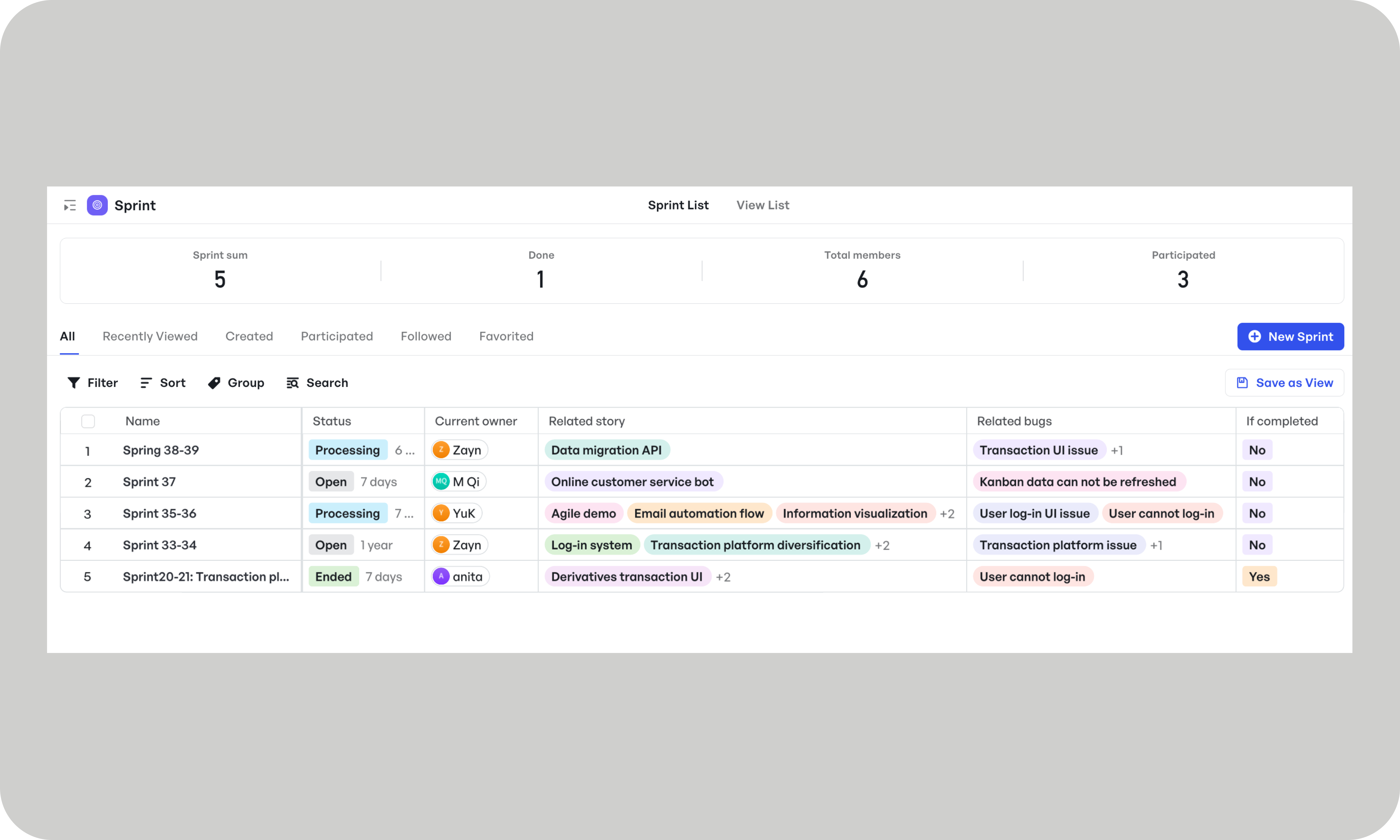 Agile project management framework with Meegle
Agile project management framework with MeegleYour sprint board gives a visual breakdown of work in progress, and your team can collaborate in real time using Meegle's built-in features:
- @mentions for instant feedback
- Role & Team assignments for clarity on ownership
- Scheduling tools to keep your sprint timeline on track
- Progress tracking dashboards to identify blockers early
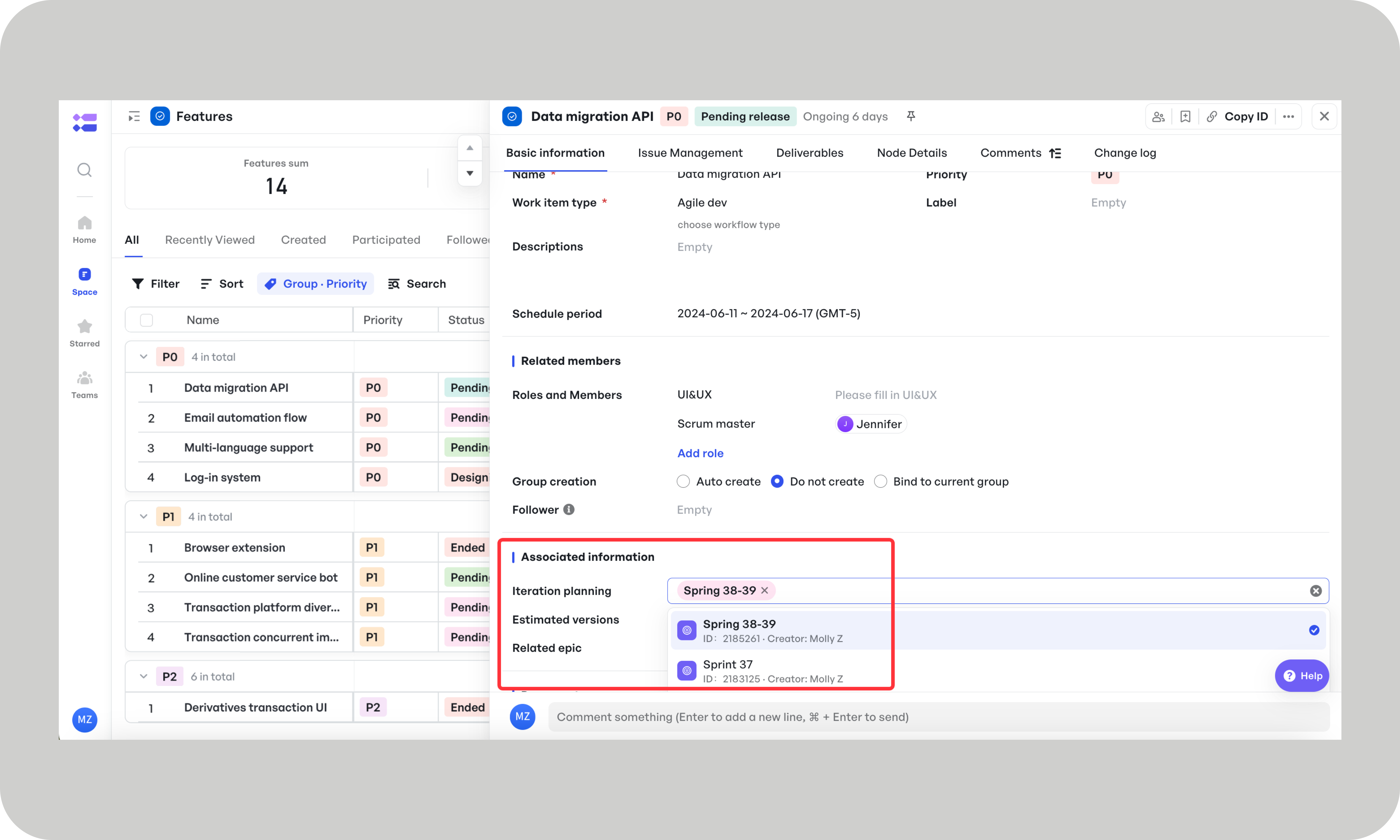 Workflow for managing adaptive project framework
Workflow for managing adaptive project frameworkWhen to use agile project management methodology:
- Agile fits fast-moving teams with shifting priorities—like product development, creative work, or experimental launches—where feedback and collaboration drive results.
For example, a mobile app team might release a new feature every two weeks, gather user feedback, and quickly iterate based on what they learn.
When not to use agile project management methodology:
- Skip Agile for fixed-scope projects, tight compliance requirements, or layered approvals like government IT projects or enterprise ERP rollouts.
| Pros | Cons |
|---|---|
| Encourages collaboration and speed | Can lack structure for large project teams |
| Delivers value in smaller chunks | Scope creep risk without guardrails |
| Responds well to change | Not ideal for fixed-cost contracts |
Suggested Read:👉What is Agile Project Management?
Project management methodology 2: Scrum
Quick facts: Year introduced: 1995 Created by: Jeff Sutherland & Ken Schwaber Where: Presented at OOPSLA (Object-Oriented Programming Conference) Famous example: Salesforce uses Scrum to manage cross-functional product teams
What is Scrum?
Scrum is a structured Agile framework. Here, projects happen in sprints with fixed roles (Scrum Master, Product Owner, Team) and rituals like standups, sprint planning, reviews, and retrospectives.
In practice:
Scrum is ideal for projects that require a high level of collaboration and continuous improvement, like software development or marketing campaigns with iterative goals.
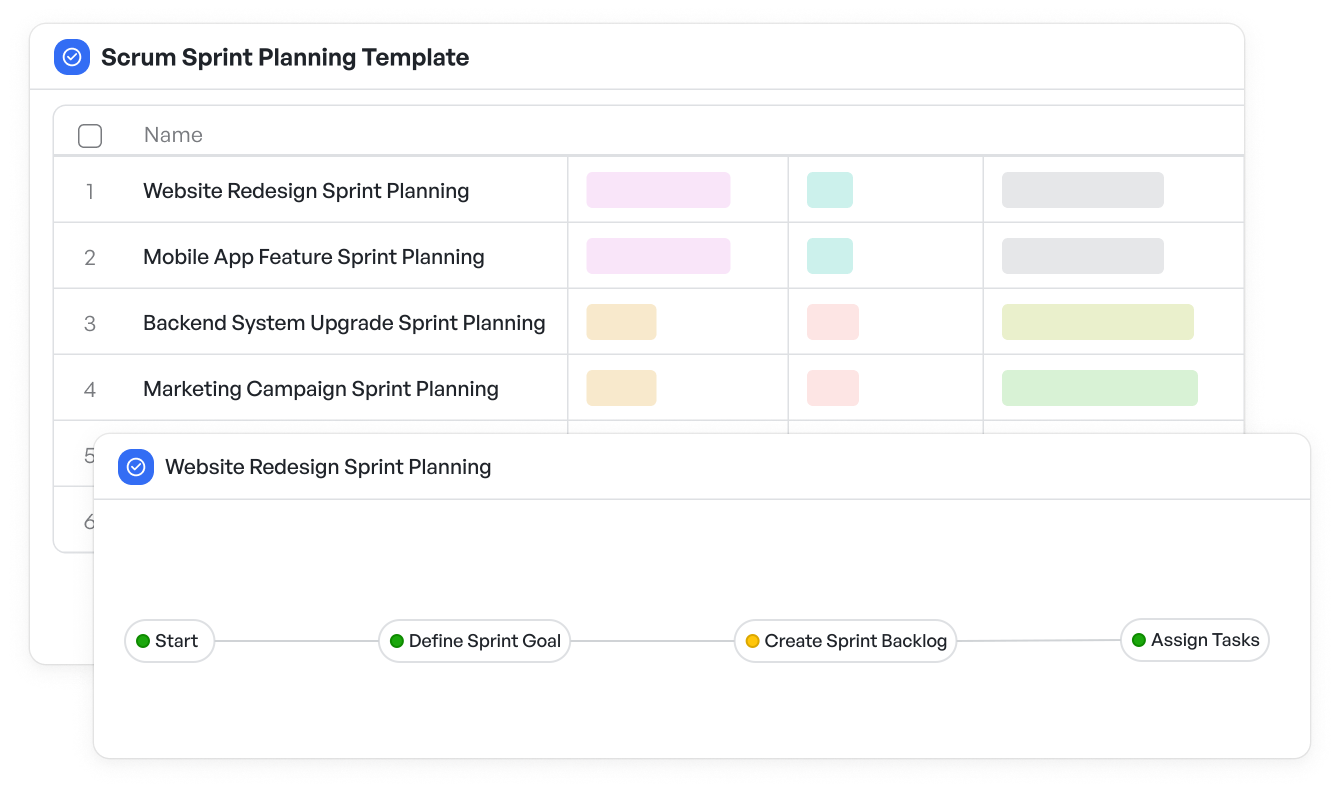 Typical scrum PMM template
Typical scrum PMM templateWith Meegle's Scrum Sprint Planning template, your team can:
- Plan sprints: Break down tasks into manageable user stories, set timelines, and assign responsibilities—whether it's developing a new feature or planning a content release.
- Track progress: Use Meegle's node-driven workflow to visualize your sprint, moving tasks from "To Do" to "In Progress" to "Completed" while staying aligned with your sprint goals.
- Hold daily standups: Keep your team on track with quick status updates, flagged blockers, and clear action items—all in the same platform.
For example, your SaaS team might use Meegle to plan a two-week sprint focused on a new feature launch. Each sprint cycle includes daily standups tracked via Meegle's visual workflows, while retrospective feedback helps streamline the process for the next round.
So, how is this methodology different from Agile?
Short answer? All Scrum is Agile, but not all Agile is Scrum.
Long answer?
| Agile (Philosophy) | Scrum (Framework) |
|---|---|
| A mindset or set of values (from the Agile Manifesto) | A defined implementation of Agile with strict guidelines |
| Flexible, can be adapted freely | Time-boxed sprints, daily standups, and role-based |
| Doesn't prescribe specific roles | Requires Product Owner, Scrum Master, and Development Team |
| Can be combined with Lean, Kanban, or XP | Has its own ceremonies: sprint planning, reviews, etc. |
Further reading: Scrum vs Agile project management methodology
When to use Scrum:
- Scrum fits small, cross-functional teams working on complex products. It's ideal when PMs break work into increments, with feedback driving continuous improvement.
For example, a SaaS team building a new dashboard feature might plan the work across several sprints, gather user feedback after each release, and refine the feature based on real-world usage.
When not to use Scrum:
If your project goals are unclear or have rigid deadlines, don't use Scrum. An example is a branding project with rotating contributors and hard launch dates.
| Pros | Cons |
|---|---|
| Defined roles clarify ownership | Can feel rigid if roles aren't respected |
| Frequent feedback improves quality | Daily meetings can drain productivity |
| Predictable sprint cadence builds focus | Not ideal for non-collaborative teams |
Project management methodology 3: Kanban
Quick facts: Year introduced: 1940s (adapted for knowledge work in 2007) Created by Taiichi Ohno (Toyota) and evolved by David J. Anderson Famous example: Zara uses Kanban-style systems to manage product flow and inventory in real time
What is Kanban?
Kanban is a visual workflow method that uses boards and cards to manage tasks. It limits work in progress (WIP) to keep things flowing smoothly, without needing time-boxed sprints or rigid roles.
In practice:
Kanban is perfect for teams that manage ongoing, high-volume work like customer support, IT operations, or content pipelines.
With Meegle's Kanban View, you can track tasks or tickets as they move through stages like "To Do,"**** "Doing,"**** and**** "Done." For example, your support team can manage incoming tickets by assigning each one a card, tagging priorities, and updating status as the issue progresses.
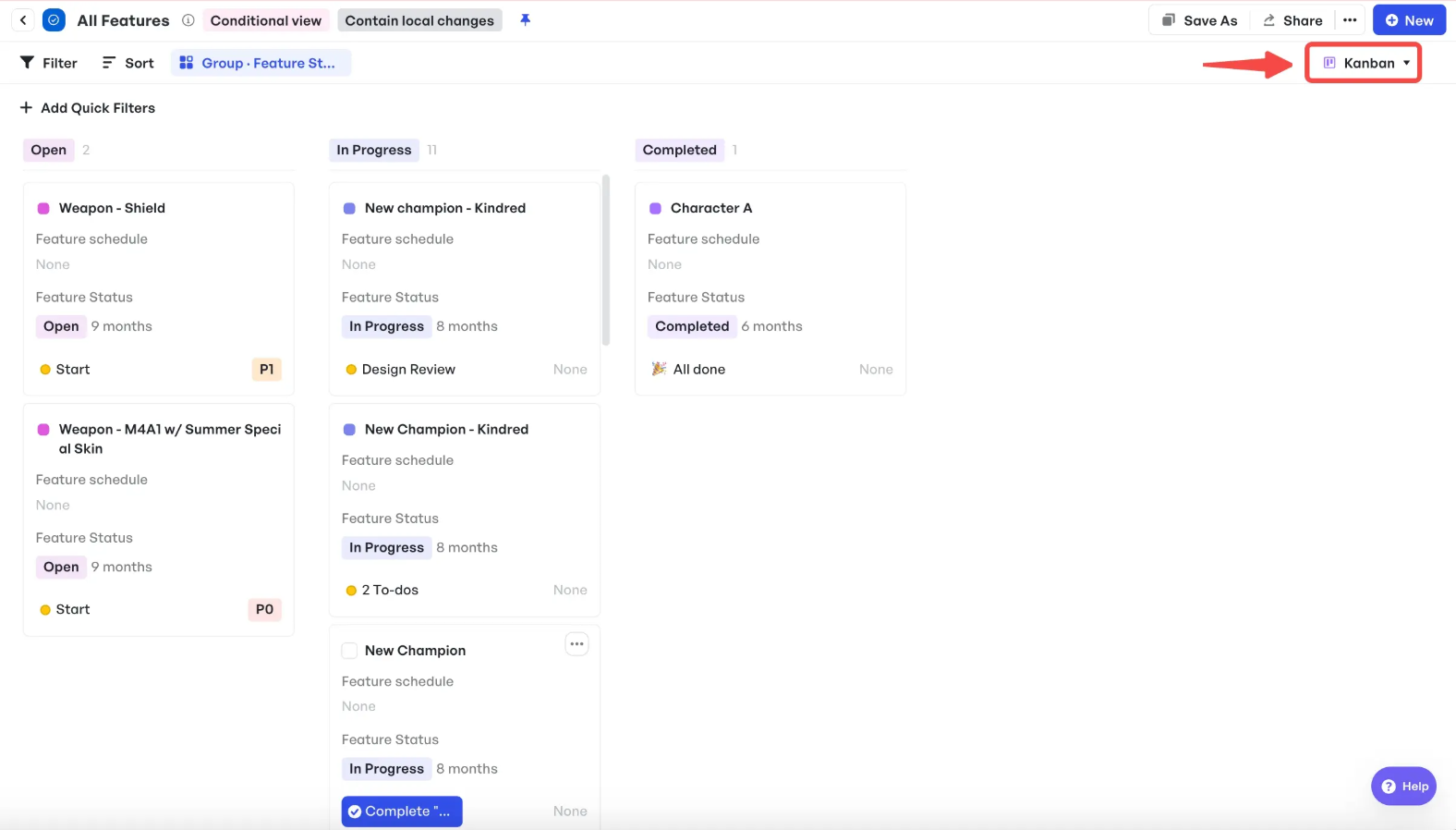 Kanban methodology: Vertical board view
Kanban methodology: Vertical board viewMeegle supports two Kanban layouts:
- Vertical Kanban board: See tasks stack up in columns as work progresses. Ideal for quick visual scanning of task load.
- Horizontal swimlane view: Group tasks by assignee, department, or priority—great for seeing how work is distributed across the team.
 Kanban methodology: Horizontal swimlane view
Kanban methodology: Horizontal swimlane viewEach Kanban card includes:
- Task name, current status, priority, schedule, and owner
- Real-time collaboration tools like @mentions and in-card comments
- Custom fields for tracking additional data, like issue type or deadline flexibility
Need a broader view of what's at stake?
You can expand any card into a detailed overview to monitor project progress, dependencies and deliverables at a glance.
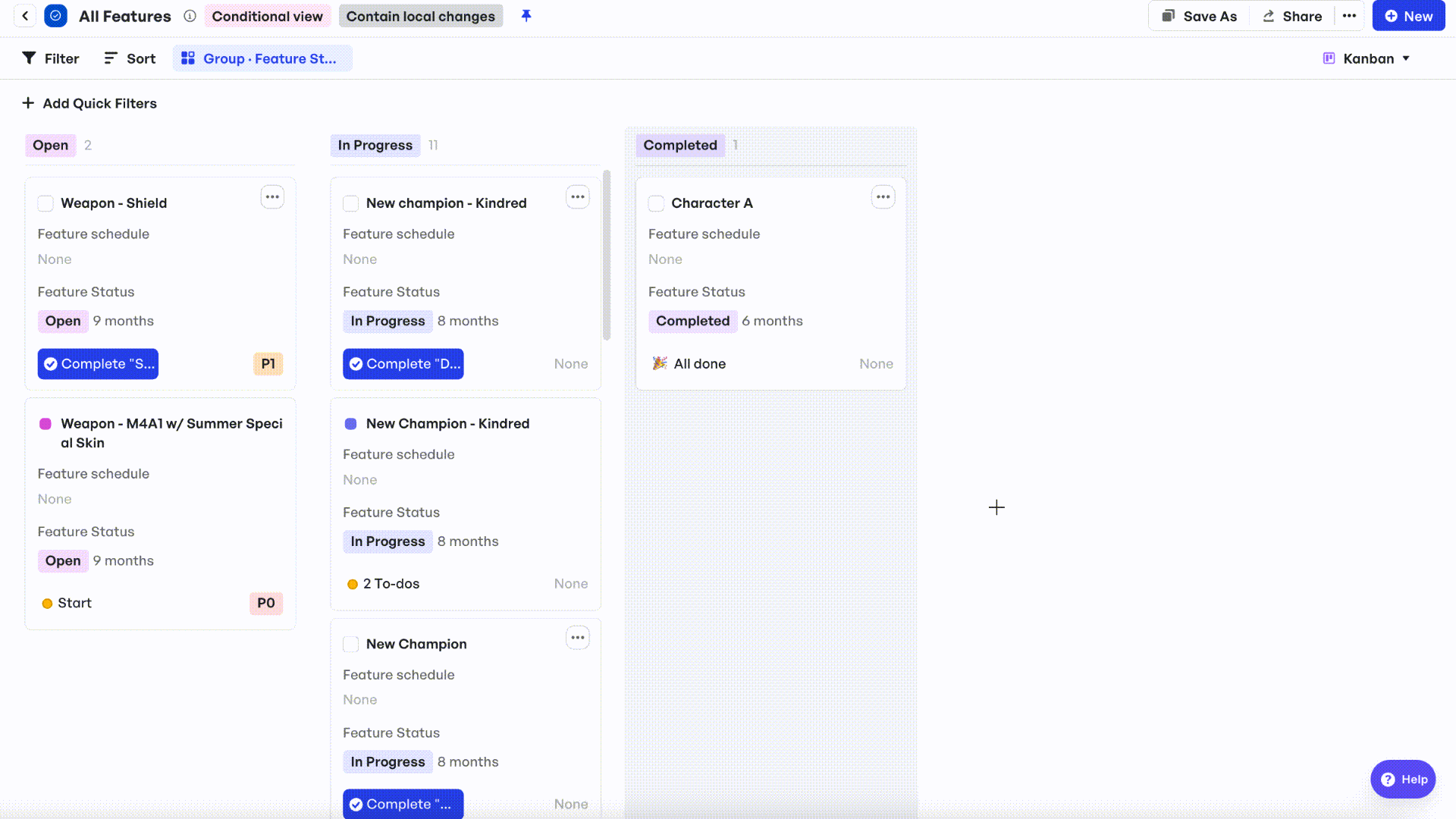 Expand cards to monitor broad project execution
Expand cards to monitor broad project executionWhen to use Kanban:
- Kanban works best for continuous workflows where priorities shift often, like support teams, DevOps, or editorial calendars.
For example, a support team might use Kanban to triage incoming tickets, assign them by priority, and track progress in real time across the board.
When not to use Kanban:
Avoid Kanban in deadline-driven projects or ones that need sprint planning and formal roles, like launching a new product line with fixed release dates and multiple approval stages.
| Pros | Cons |
|---|---|
| Easy to implement and flexible | Lack of time constraints can delay delivery |
| Great for visualizing and balancing workload | Doesn't enforce role clarity or prioritization |
| Encourages incremental improvement | Easy to overload if WIP limits aren’t respected |
Also read: 👉Kanban Vs. Agile project management methodology
Project management methodology 4: Waterfall
Quick facts: Year introduced: 1970 Created by: Dr. Winston W. Royce Where: First outlined in a paper on software development Famous example: NASA used Waterfall to plan and execute space shuttle programs
What is Waterfall?
Waterfall is a linear project management method where work moves through fixed phases: requirements, design, development, testing, and delivery, in that exact order. Each phase must be completed before the next one begins, making it best suited for projects with well-defined goals and minimal expected changes.
In practice:
Waterfall is best for projects with well-defined requirements and phase-by-phase timelines like government contracts, hardware development, or construction.
Using Meegle's Project Life Cycle template, you can create a step-by-step plan that mirrors the traditional Waterfall structure:
Initiation → Planning → Execution → Monitoring → Closure
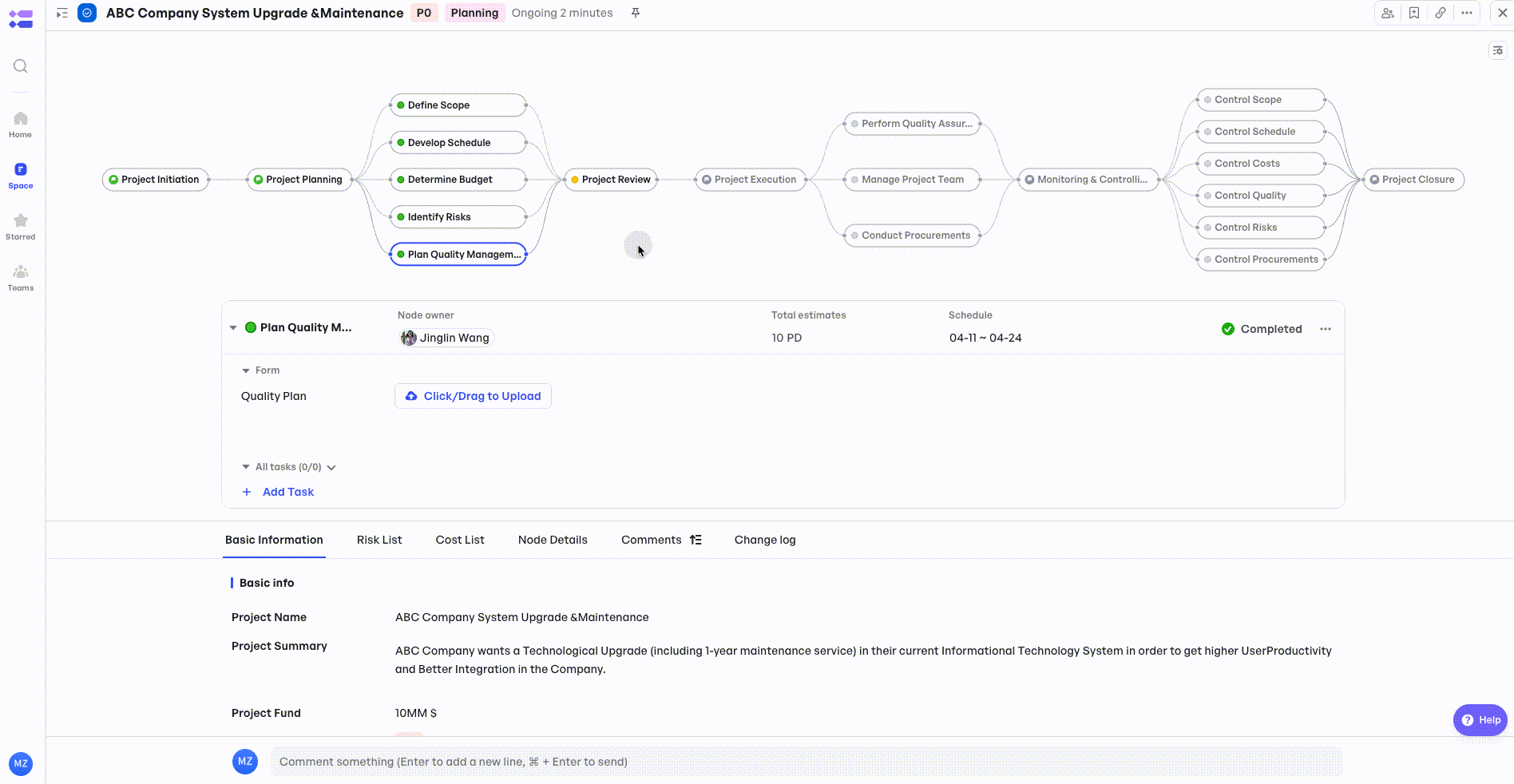 Typical waterfall project management workflow
Typical waterfall project management workflowEach phase in your project becomes a node in Meegle. And the project moves forward only after the previous node is complete.
For example, a hardware team building a physical device might use Meegle to move from detailed design specs, to prototyping, to manufacturing—with strict handoffs between departments.
Inside each node, you can:
- Attach deliverables
- Set task dependencies
- Assign ownership and deadlines
You can use Meegle's Gantt Chart to visualize the entire timeline, link tasks across phases, and track dependencies in real time.
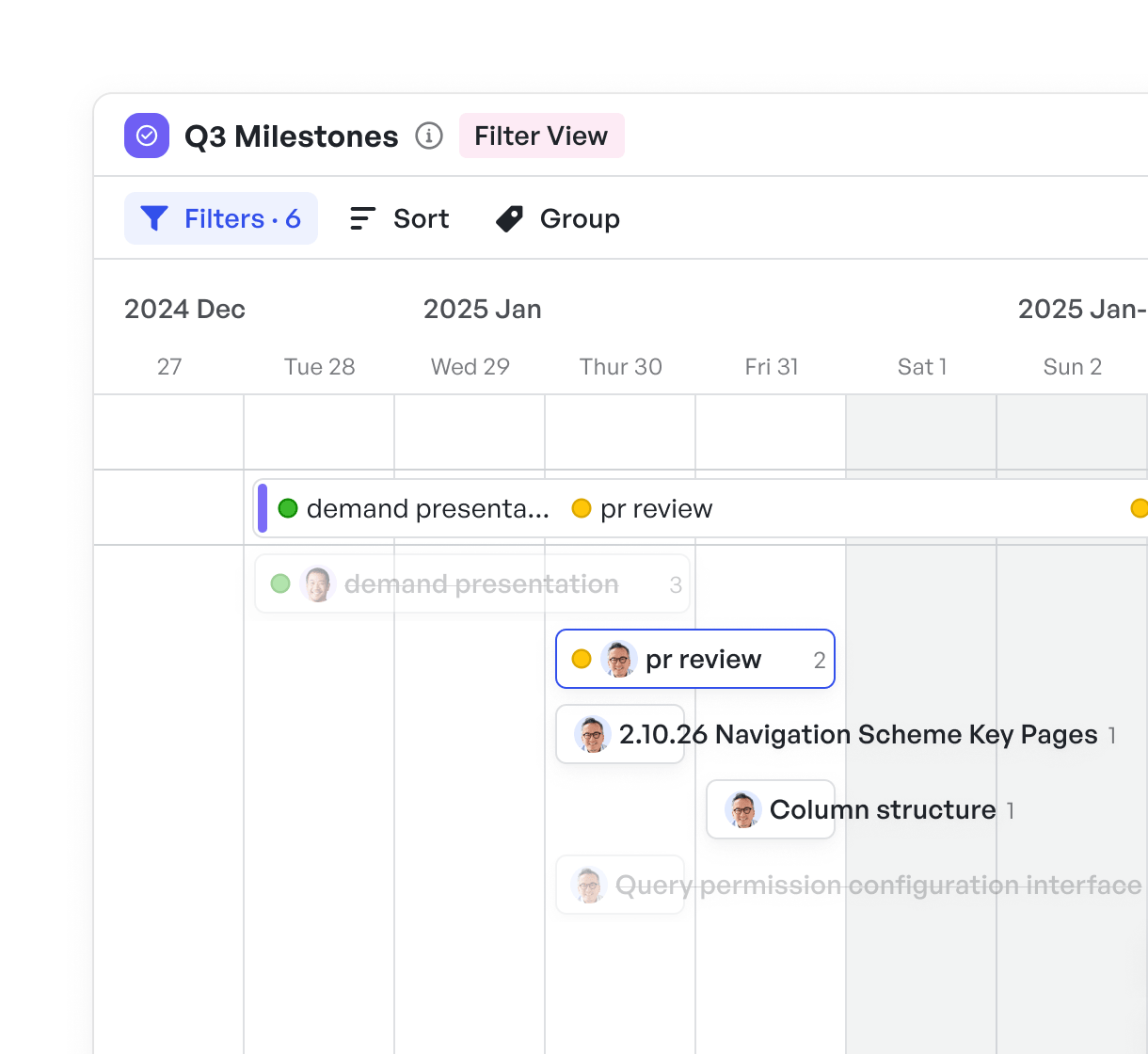 Gantt chart for managing projects in Waterfall
Gantt chart for managing projects in WaterfallAs deadlines approach, Meegle's automation nudge task owners so nothing slips through.
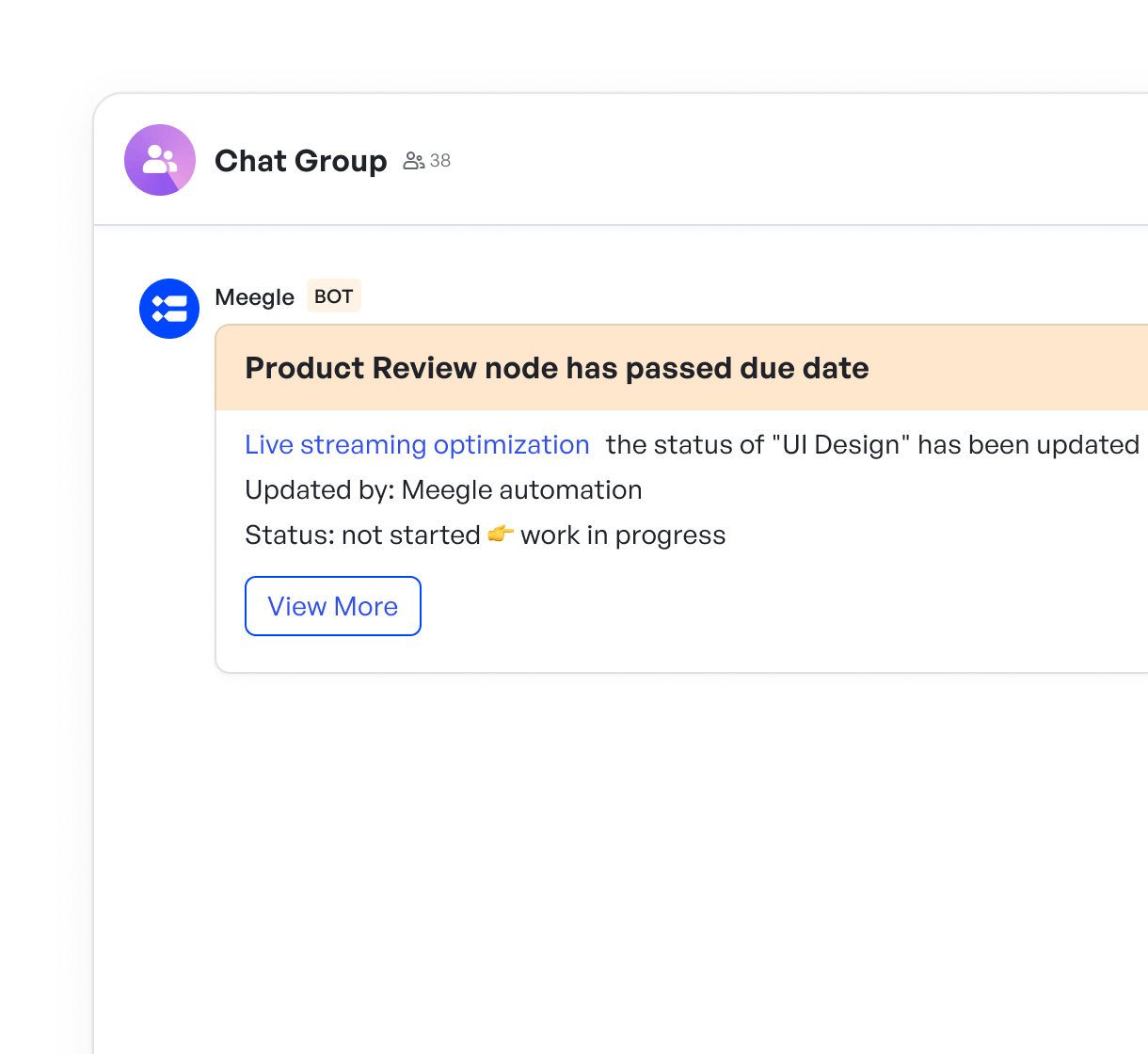 Due date alerts
Due date alertsMeanwhile, built-in dashboards (charts) let you report progress to stakeholders and flag issues early. You can even create a dedicated "risk work item" to manage mitigation plans.
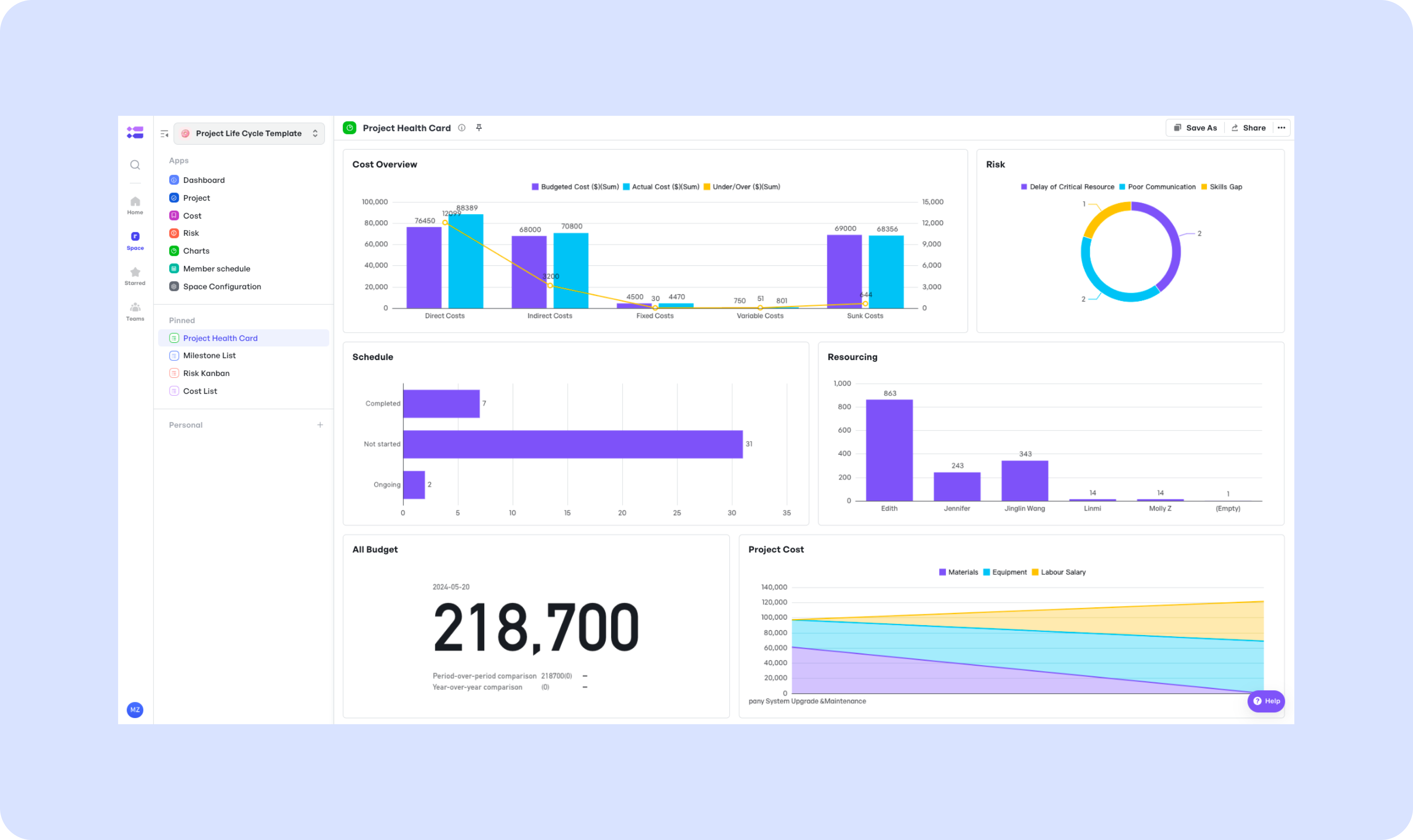 Sample dashboard: Project Health Card
Sample dashboard: Project Health CardWhen to use Waterfall:
- Choose Waterfall only when there are defined requirements and stable scope, where each stage depends on completing the last, like in construction, manufacturing, or compliance-heavy industries.
For example, a construction firm building a commercial office complex might follow a strict phase-based approach:
Design → permitting → foundation → structure → inspection
When not to use Waterfall:
Waterfall isn't a fit for projects with evolving needs or unclear goals. Its structure leaves little room for change midstream.
| Pros | Cons |
|---|---|
| Clear structure and documentation | Inflexible once work begins |
| Easier to manage large teams and vendors | Slow to adapt to changing requirements |
| Works well for fixed budgets and deadlines | Late-stage testing may surface critical issues too late |
Suggested Read:👉A Comparative Guide to Waterfall vs Agile
Project management methodology 5: Lean
Quick facts: Year introduced: 1940s (formalized in the 1990s) Created by: Toyota Production System (Taiichi Ohno, Shigeo Shingo) Famous example: Toyota uses Lean to streamline manufacturing with minimal waste and maximum value
What is Lean methodology?
Lean methodology focuses on eliminating waste, maximizing efficiency, and delivering only what adds value to the customer. It promotes continuous improvement and encourages teams to use resources wisely, doing more with less, without compromising on quality.
In practice:
Lean project management is ideal for environments like these:
- A startup is building a minimum viable product (MVP) on a tight timeline and budget. Meegle helps the team identify what's essential, review blockers daily, and deprioritize anything that doesn’t deliver user value.
- A hospital operations team is trying to streamline patient intake. They use Meegle to review yesterday's patient flow data, set goals for today, and track incremental improvements—all within a visual, easy-to-update system.
With Meegle's Lean daily management template, teams can structure their workday around short daily meetings that eliminate inefficiencies.
 Lean project management template
Lean project management templateMeegle's Table view makes it easy to:
- Log daily huddles and action items
- Sort and filter tasks by priority, owner, or status
- Pin or freeze key columns (e.g. today's goals, bottlenecks) for better focus
- Continuously improve by tracking small experiments and documenting what works
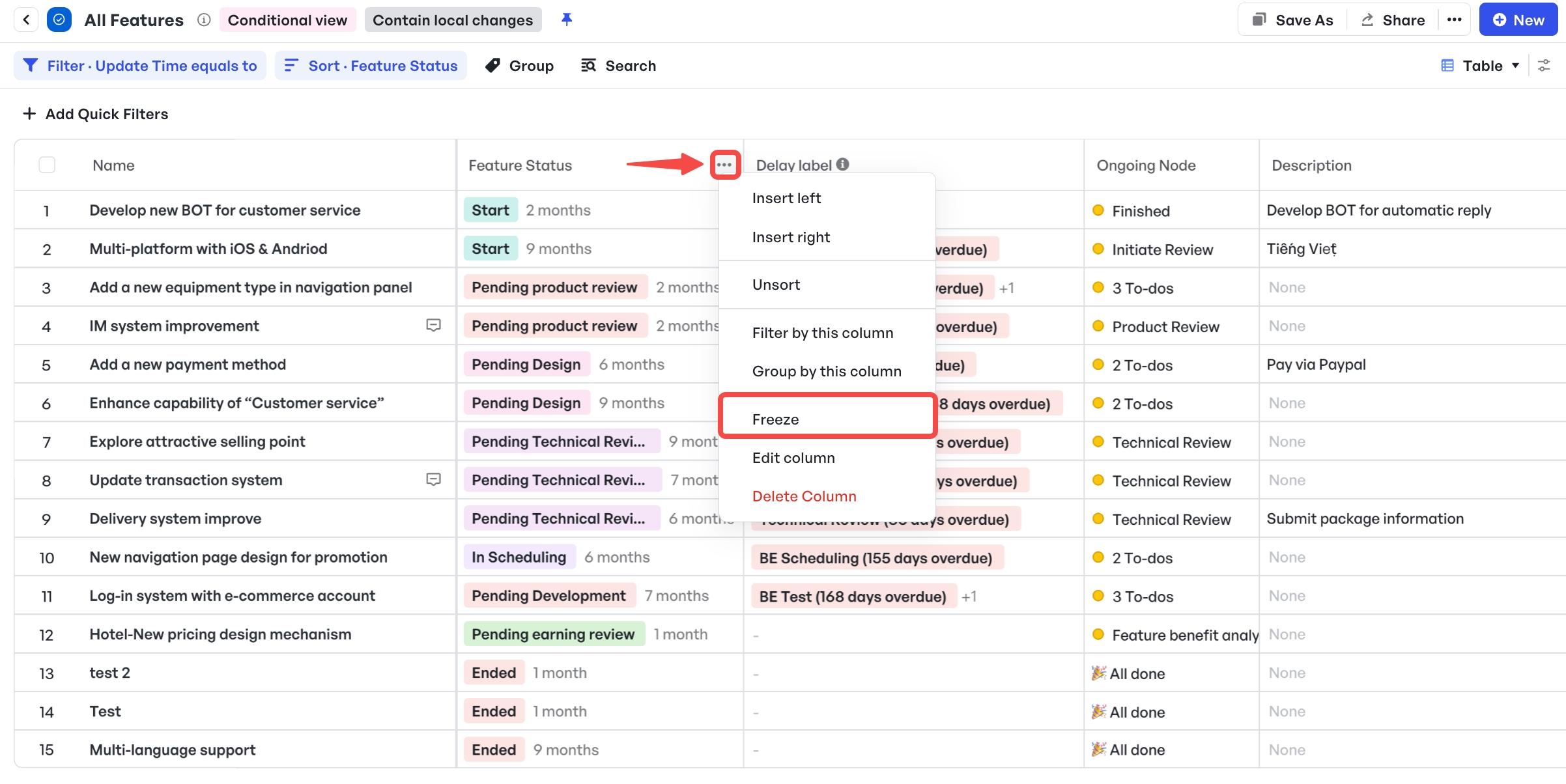 Lean resource management with table view
Lean resource management with table viewBy making every task and blocker visible, teams can act fast, collaborate, and continuously fine-tune how they work.
When to use Lean methodology:
- The Lean PMM is ideal when you're optimizing processes, cutting unnecessary costs, or focusing on customer value. It's popular in startups, operations, manufacturing, and service-based systems that benefit from continuous iteration.
For example, a startup might use Lean to prioritize only the features needed for an MVP, helping them launch quickly while conserving budget and resources.
When not to use Lean methodology:
While Lean PMM flexibility is a plus for adaptive teams, it can also clash with rigid workflows. As a result, avoid it in projects requiring extensive upfront planning.
| Pros | Cons |
|---|---|
| Maximizes customer value, minimizes waste | Risk of under-documentation or over-simplification |
| Encourages continuous improvement (Kaizen) | Needs disciplined, empowered teams to work effectively |
| Supports fast, efficient delivery | Not well-suited for large, fixed-scope projects |
Note: Six Sigma is closely related to the Lean methodology. While the latter reduces waste and maximizes value, the former reduces defects and improves quality through data-driven decision-making. You can combine both into a "Lean Six Sigma approach" for efficiency and precision.
Project management methodology 6: PRINCE2
Quick facts: Year introduced: 1989 (updated 1996) Created by: UK government's Central Computer and Telecommunications Agency (CCTA) Famous example: The UK government uses PRINCE2 for infrastructure, IT, and public sector projects
What is PRINCE2?
PRINCE2 (Projects IN Controlled Environments) is a process-based methodology focused on structure, governance, and risk control. It divides projects into clearly defined stages, with formal roles, documentation, and review points.
In practice:
PRINCE2 is ideal for complex, high-stakes projects that require strong governance, risk control, and stage-by-stage oversight.
With Meegle's PRINCE2 Team Plan Coordination template, you can break your project into the methodology's seven stages, each represented as a node:
- Starting up a project
- Initiating a project
- Directing a project
- Controlling a stage
- Managing product delivery
- Managing stage boundaries
- Closing a project
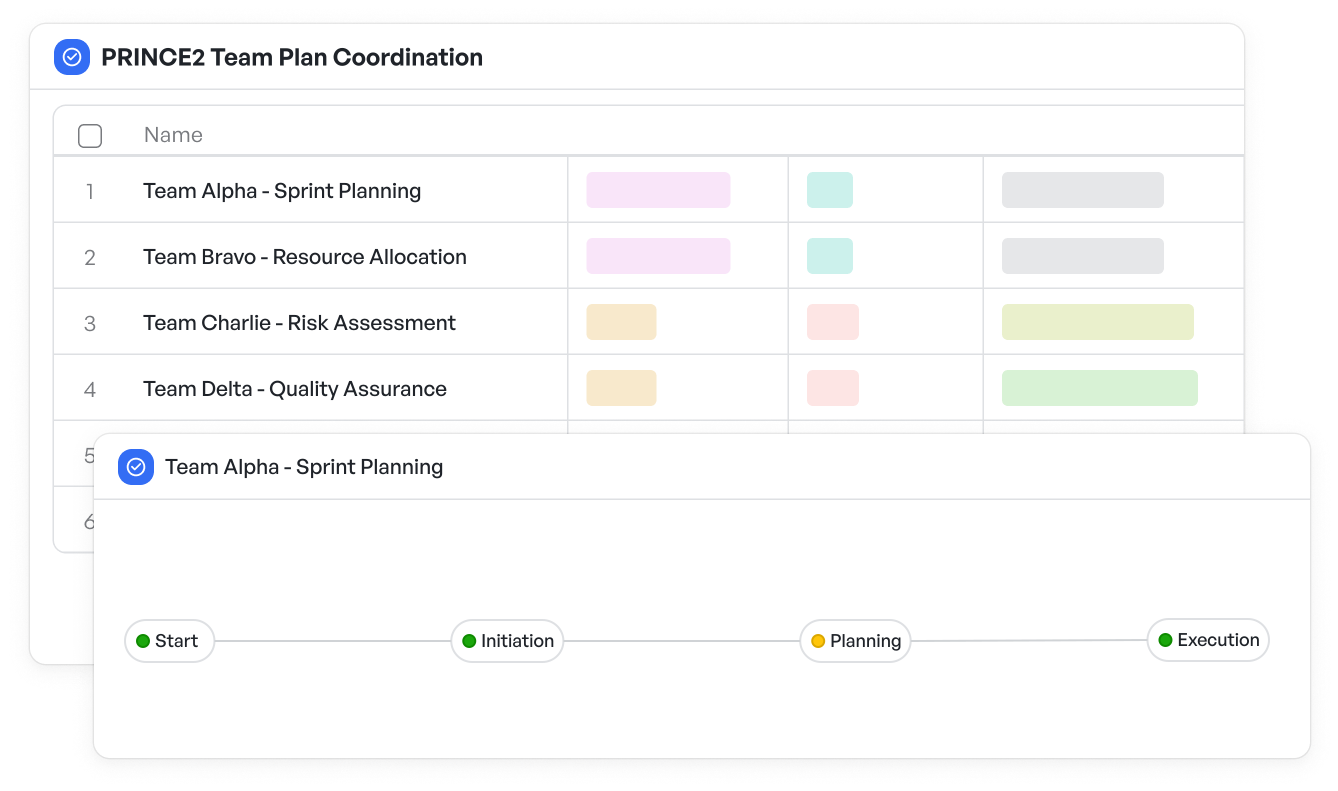 PRINCE2 for managing project lifecycle
PRINCE2 for managing project lifecycleFor example:
- A city council rolling out a new transit system uses Meegle to assign each project phase to a department lead (like infrastructure, legal, and public relations) for full accountability and audit trails.
- A global enterprise deploying software across several regions uses the same framework to manage localization, regulatory compliance, and staggered rollouts.
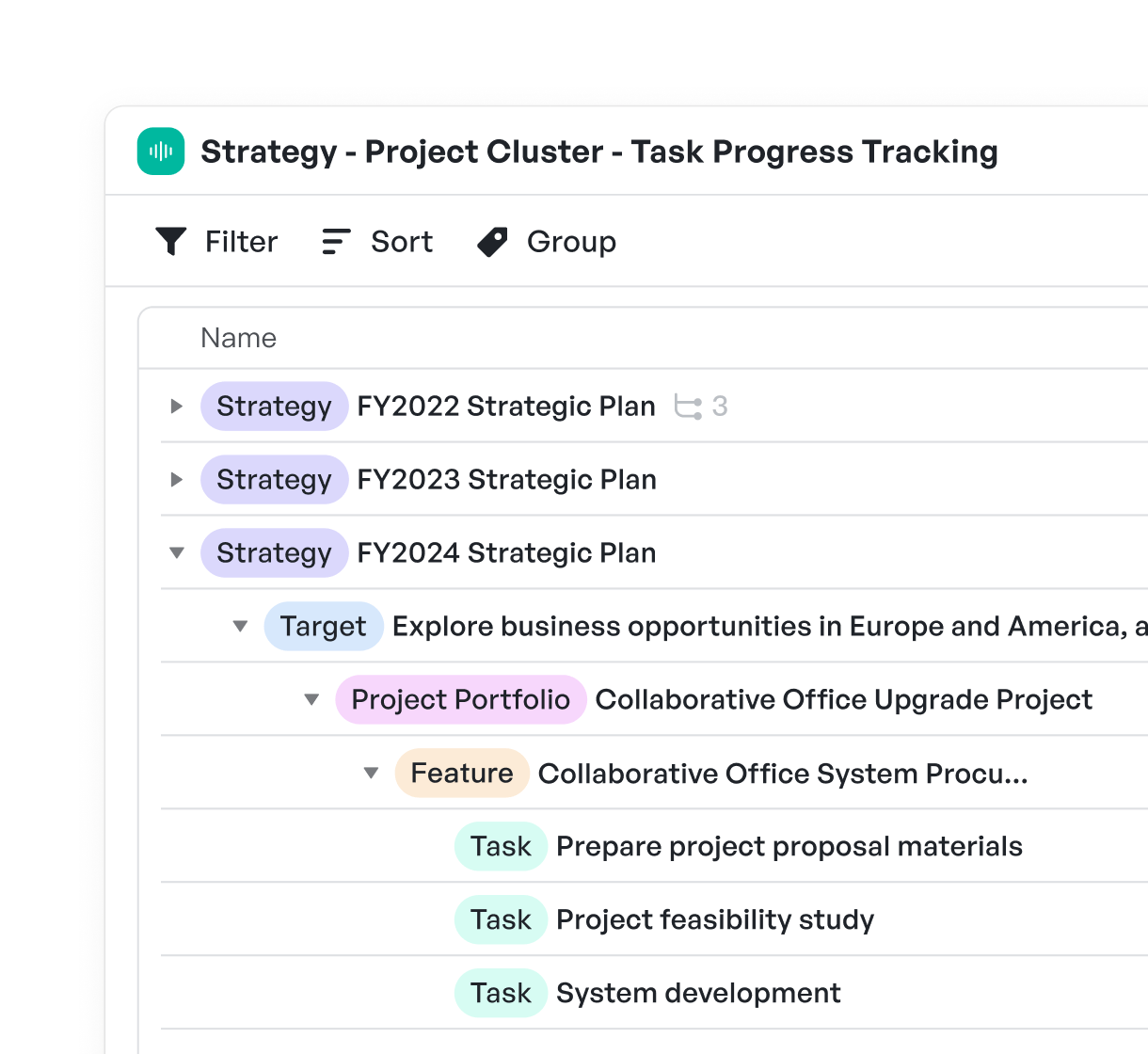 Task progress tracking for most important project tasks
Task progress tracking for most important project tasksWithin each node, Meegle helps project managers and teams:
- Track task progress for key deliverables using the Timeline and Task Views
- Attach critical documents (like business cases or stage authorization) via the Docs tab
- Assign clear Roles & Teams to maintain accountability across departments
- Log and monitor threats using the Risk tab, detailing likelihood, impact, and mitigation
- Use automation and due-date alerts to keep each stage on schedule
When to use PRINCE2:
- Use PRINCE2 for large, complex, or regulated projects that require formal planning, documentation, and oversight. It's ideal for cross-functional teams or multi-vendor setups.
For example, a government agency launching a nationwide digital ID system might use PRINCE2 to ensure structured execution across legal, technical, and policy teams.
When not to use PRINCE2:
PRINCE2 is not for small, fast-paced projects where heavy documentation delays progress. Teams unfamiliar with structured frameworks may also struggle with it.
| Pros | Cons |
|---|---|
| Highly structured and scalable | Heavy documentation and admin load |
| Strong governance and accountability | Can feel bureaucratic and slow |
| Works well in regulated environments | Requires training and certification to implement fully |
Project management methodology 7: Extreme Programming (XP)
Quick facts: Year introduced: 1996 Created by: Kent Beck Famous example: Early Facebook teams used XP to ship fast and refactor often
What is Extreme Programming (XP)?
Extreme Programming (XP) is an Agile framework for software development teams that need to move fast without sacrificing quality. It relies on short development cycles, continuous testing, pair programming, and tight user-developer collaboration.
In practice:
Extreme Programming (XP) is all about speed, continuous delivery, and uncompromising code quality. Hence, it is ideal fast-moving, engineering-led teams.
Here are some examples:
- A fintech startup ships small updates daily. Developers write tests before code, push updates continuously, and track test results inside Meegle to ensure every build meets standards.
- A software agency delivering mission-critical apps uses Meegle to coordinate pairs of devs, QA, and client reviewers. Feedback is logged instantly, tests are tied to features, and each mini-release is documented across nodes.
 Extreme project management template for rapid application development
Extreme project management template for rapid application developmentWith Meegle's Frequent Small Releases template, XP teams can:
- Break projects into nodes for each phase: planning, development, testing, and release
- Use the Test tab to implement Test-Driven Development (TDD)—logging test cases, outcomes, and linking them directly to features
- Assign team members using Roles & Teams, making it easy to implement pair programming and rotate responsibilities
- Capture user or stakeholder input in real time through Node Forms—perfect for customer-centric feedback loops
- Use the Risk tab to flag technical debt, unstable builds, or blocker bugs before they derail deployment
When to use Extreme Programming (XP):
- XP works best when speed and code quality are critical. It is ideal for small, highly technical teams that embrace feedback loops and clean code.
For example, a fintech company might use XP to deliver daily updates, ensuring each release is tested, refined, and responsive to user feedback in real time.
When not to use Extreme Programming (XP):
XP isn't suitable for projects where users or stakeholders can't provide frequent input. It also doesn't suit non-technical teams or projects without a strong testing culture.
| Pros | Cons |
|---|---|
| Rapid feedback improves software quality | Requires high developer discipline and maturity |
| Prevents bugs early through TDD | Can feel chaotic without experienced leadership |
| Enhances collaboration and knowledge sharing | Not ideal for large, distributed teams |
Project management methodology 8: Six Sigma
Quick facts: Year introduced: 1986 Origin: Motorola, popularized by GE under Jack Welch Famous example: GE reportedly saved $10 billion by applying Six Sigma company-wide
What is Six Sigma project management methodology?
Six Sigma is a data-driven project management approach that focuses on reducing defects and improving quality by identifying and eliminating variability in processes. Rooted in statistical analysis, it follows two key frameworks:
- DMAIC (Define, Measure, Analyze, Improve, Control) for existing processes
- DMADV for new ones
In practice:
Six Sigma shines in high-stakes, process-heavy environments like manufacturing, healthcare, and finance.
Say your company runs a nationwide fulfillment process and needs to reduce delays. Meegle helps you map workflows and track metrics in real time. Your team can:
- Create visual workflows to spot process bottlenecks
- Use milestones to track improvement targets (like reducing shipping errors by 30%)
- Collaborate across departments with shared dashboards
- Assign root cause analysis tasks directly in Meegle and monitor resolution progress
This allows even non-technical teams to take part in quality improvement efforts.
When to use Six Sigma:
- Use Six Sigma when precision matters.
For example, large teams can use Six Sigma to improve customer service call handling, minimize billing errors, or tighten operational processes.
When not to use Six Sigma:
Six Sigma is not ideal for early-stage startups, creative teams, or fast-iterating digital products—anywhere speed and flexibility trump formal quality metrics.
| Pros | Cons |
|---|---|
| Highly structured and measurable | Complex to implement |
| Great for process optimization | Requires data discipline and training |
| Reduces defects and improves quality | May slow down teams in fast-moving environments |
Project management methodology 9: Critical Path Method (CPM)
Quick facts: Year introduced: Late 1950s Origin: Developed by DuPont for managing plant maintenance projects Famous example: Used in construction of the World Trade Center
What is the Critical Path Method?
The Critical Path Method (CPM) is a project scheduling technique that identifies the longest sequence of dependent tasks — the "critical path" — which must be completed on time to ensure the project finishes as scheduled. It helps teams prioritize, allocate resources efficiently, and understand which delays will directly impact deadlines.
The main idea: if a task on the critical path is delayed, the entire project will be delayed.
In practice:
CPM is widely used in construction, engineering, and other fields where projects follow a clear timeline and dependency structure.
Let's say you're managing a physical gym expansion. With Meegle, you can:
- Visually map task dependencies to determine the critical path (e.g., permits → groundwork → construction → inspection → launch)
- Assign deadlines and let Meegle highlight task slippage or risk areas
- Use the shared schedule view, so every team (legal, contractors, design) sees how their work affects the full timeline
- Receive real-time updates when task statuses shift, so you can reallocate or escalate as needed
When to use Critical Path Method:
- CPM is perfect for complex, deadline-driven projects where task dependencies are fixed and delays are expensive.
For example, CPM is ideal for projects like infrastructure builds, product launches, or event planning.
When not to use Critical Path Method:
Avoid CPM for flexible, exploratory work or creative campaigns with undefined stages.
| Pros | Cons |
|---|---|
| Offers clear schedule visibility | Less flexible in fast-changing projects |
| Highlights crucial tasks | Requires upfront planning and structure |
| Enables efficient resource planning | Doesn't account for uncertainty or buffers unless paired with other methods |
Project management methodology 10: Hybrid
Quick facts: Year introduced: Early 2010s (as a response to Agile vs. Waterfall conflicts) Origin: Emerged from combining traditional (Waterfall) and Agile principles Famous example: IBM used hybrid methods to manage large-scale software development and system updates
What is the hybrid project management methodology?
Hybrid project management blends the structure of traditional methods (like Waterfall) with the flexibility of Agile. For example, you can use:
- Predictive planning for scope, budget, and compliance
- Iterative delivery for development, testing, and feedback loops
In summary, hybrid PMM is a detailed roadmap, but one with detours for when needed, without losing your destination.
In practice:
A tech company launching a financial product might use Waterfall to plan regulatory requirements, and Agile sprints to iterate the front-end user experience.
With Meegle, you can:
- Use milestone planning for the fixed aspects (e.g., launch dates, compliance reviews)
- Run Agile boards for iterative tasks like feature development or bug fixing
- Combine both views in one workspace, so regulatory teams and product designers can collaborate
- Set task dependencies and triggers to shift Agile sprints when milestone timelines move
When to use hybrid project management methodology:
- Use Hybrid when you need control of traditional methods (budgets, contracts, stakeholders) but the speed and feedback loops of Agile.
For example, you manage cross-functional teams doing fast-moving, fixed-constraints projects. In this case, this PMM is ideal.
When not to use project management methodology:
Avoid Hybrid if your team lacks the discipline to manage two methodologies at once. Also, it's not a fit if your project is either exploratory or structured (not both).
| Pros | Cons |
|---|---|
| Balances structure with adaptability | Requires experienced project managers |
| Great for complex, cross-functional teams | Can become messy if roles and workflows aren't clear |
| Encourages incremental delivery without losing sight of the big picture | Not ideal for small, fast-moving teams with simple needs |
Project management methodology 11: Precedence Diagramming Method (PDM)
Quick facts: Year introduced: 1960s Origin: Developed as part of the Critical Path Method evolution Famous example: Used in construction and aerospace projects like NASA's shuttle programs
What is the precedence diagramming method?
The Precedence Diagramming Method (PDM) is a visual scheduling technique that maps out project tasks as nodes and connects them with arrows to show dependencies. It helps teams define the sequence of activities and identify which tasks must start or finish before others can begin.
There are four dependency types in PDM:
- Finish-to-Start
- Start-to-Start
- Finish-to-Finish
- Start-to-Finish
In practice:
Say you're building a new feature for an app. The design phase must finish before development can begin (Finish-to-Start), and testing can begin halfway through development (Start-to-Start).
With Meegle, you can:
- Use node-based workflows to visually map dependencies
- Assign tasks with custom logic and conditions (e.g., “start Task B only when Task A is 75% complete”)
- Automatically adjust timelines when dependencies shift
- Use real-time updates to reallocate resources when blockers occur
This structure keeps the project flowing smoothly and helps spot delays early.
When to use precedence diagramming method:
- PDM is best for managing complex projects with interdependent tasks. It’s ideal for engineering, manufacturing, or enterprise software with cross-functional teams.
For example, an engineering team uses Meegle's node-based workflow to ensure design is complete before prototyping starts, and testing only begins after builds hit 80% completion.
When not to use precedence diagramming method:
Skip PDM for small, low-dependency projects or teams unfamiliar with dependency logic.
| Pros | Cons |
|---|---|
| Clear visualization of task relationships | Can be complex for new teams |
| Prevents scheduling conflicts and bottlenecks | Requires accurate task estimation |
| Easy to identify the critical path and adjust priorities | Updates may need careful coordination to avoid delays |
Project management methodology 12: Critical Chain Project Management
Quick facts: Year introduced: 1997 Origin: Developed by Dr. Eliyahu Goldratt, based on the Theory of Constraints Famous example: Lucent Technologies used CCPM to deliver R&D projects faster and more predictably
What is Critical Chain Project Management?
Critical Chain Project Management (CCPM) identifies a project's "critical chain" — the longest sequence of resource-dependent tasks — and builds in time buffers to manage uncertainty without inflating timelines. It emphasizes task focus, buffer management, and reducing multitasking to improve project flow.
In practice:
CCPM is effective for high-stakes projects where delays are costly and resources are limited, like R&D, pharma, or product development.
Say a product team uses Meegle's scheduling and task dependency tools to lock in resource availability and insert time buffers for design and QA. The visual timeline, then, makes it easy to spot resource bottlenecks early.
When to use Critical Chain Project Management:
- Use CCPM when resources are shared across projects and delays could impact multiple deliverables. It's ideal for engineering, R&D, and time-sensitive development teams.
For example, a startup with limited engineers uses CCPM to sequence firmware, design, and QA tasks across parallel projects. This keeps the team focused and reduces timeline overruns.
When not to use Critical Chain Project Management:
Avoid CCPM for small projects with few dependencies or full-time dedicated team members.
| Pros | Cons |
|---|---|
| Focuses on resource constraints | Can be complex to implement initially |
| Improves on-time delivery | Not suitable for ad hoc or fast-moving work |
| Adds structure to high-uncertainty projects | Requires cultural shift to limit multitasking |
Choosing the right project management methodology
Some projects need flexibility and quick feedback, while others need structure and predictability. So, there's no perfect methodology. To understand which methodology you should adopt, ask:
- What are we trying to achieve?
- How often might requirements change?
- What risks and constraints do we face?
- How involved are stakeholders throughout?
The best project management methodology depends on the unique nature of your project, its goals, timeline, and stakeholder expectations.
- Agile works well when you need fast iterations, frequent feedback, and room to adapt. It’s ideal for software development or innovation-driven projects where the end product may evolve during execution.
- Waterfall, on the other hand, is a better fit when you have clearly defined requirements and need a structured, step-by-step approach. It’s often used in construction, manufacturing, or regulatory projects where changes are costly.
- Hybrid models combine both—giving you the predictability of Waterfall with Agile’s adaptability for certain phases like prototyping or testing.
Use this quick reference to match your project type to a fitting approach.
| Sample project | Recommended methodology | Why |
|---|---|---|
| Mobile app development | Scrum | Frequent iterations and rapid user feedback |
| Infrastructure overhaul | Waterfall | Fixed scope with clear, sequential phases |
| Manufacturing process design | Lean | Focused on waste reduction and efficiency |
| Government IT rollout | PRINCE2 | Structured governance and documentation |
| MVP for startup | Extreme Programming (XP) | Fast releases, test-driven, and feedback-driven |
One tool, any methodology: How Meegle fits your workflow
Choosing a methodology is only the first step to project success; finding the project management software that adapts to all of them is even more critical.
Meegle gives you that flexibility. Whether you follow Agile, Waterfall, Lean, or hybrid models, it adjusts to your workflow.
- Supports all PMMs: Scrum, Waterfall, Kanban, Lean, PRINCE2, XP, and more
- Customizable workflows: Use drag-and-drop templates for sprint planning, milestone tracking, or risk control.
- Real-time collaboration: Team members get instant updates, can comment, and track deliverables across all stages.
- Built-in automation: Auto-assign tasks, set triggers, and eliminate repetitive work.
- Visual dashboards: Get timeline views for Waterfall or Kanban boards for Agile—switch as needed.
- Role-based access: Assign responsibilities and visibility based on stakeholder roles.
- Scalable templates: Start with small teams and scale across departments or regions.
Meegle helps you match the methodology to the project without a need to change tools as your scope expands.
One tool, endless ways to work—experience Meegle’s flexibility now.
Other resources you should check out:
FAQs
What if my team prefers different methodologies?
You can blend PMMs across departments. Use the Agile approach for dev and Waterfall methodology for compliance. Meegle lets you mix templates without losing structure or clarity.
How do I switch methodologies mid-project?
Start by mapping your current stage to the new framework's structure. Then, update workflows and communicate clearly. Meegle's visual workflows help teams transition smoothly without starting over.
Can I run a hybrid methodology without creating chaos?
Yes, with the right project management tool. Meegle lets you combine Agile sprints with Waterfall milestones, tracking everything in one place, so no one misses dependencies or timelines.
The world’s #1 visualized project management tool
Powered by the next gen visual workflow engineRead More
Check All BlogsStart creating impactful work today
